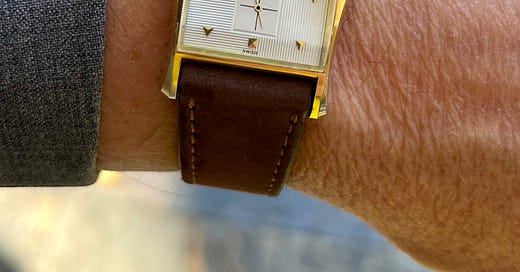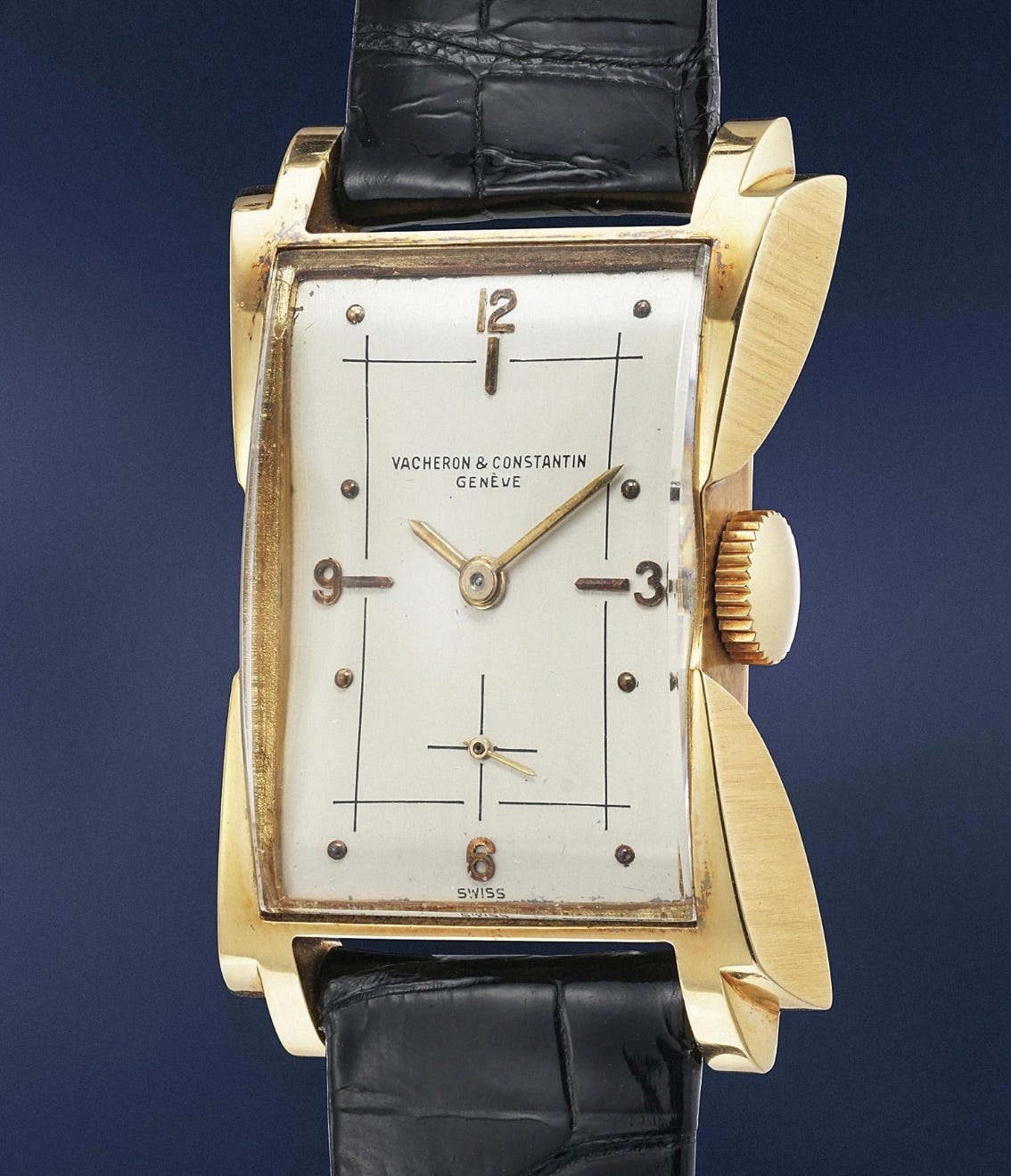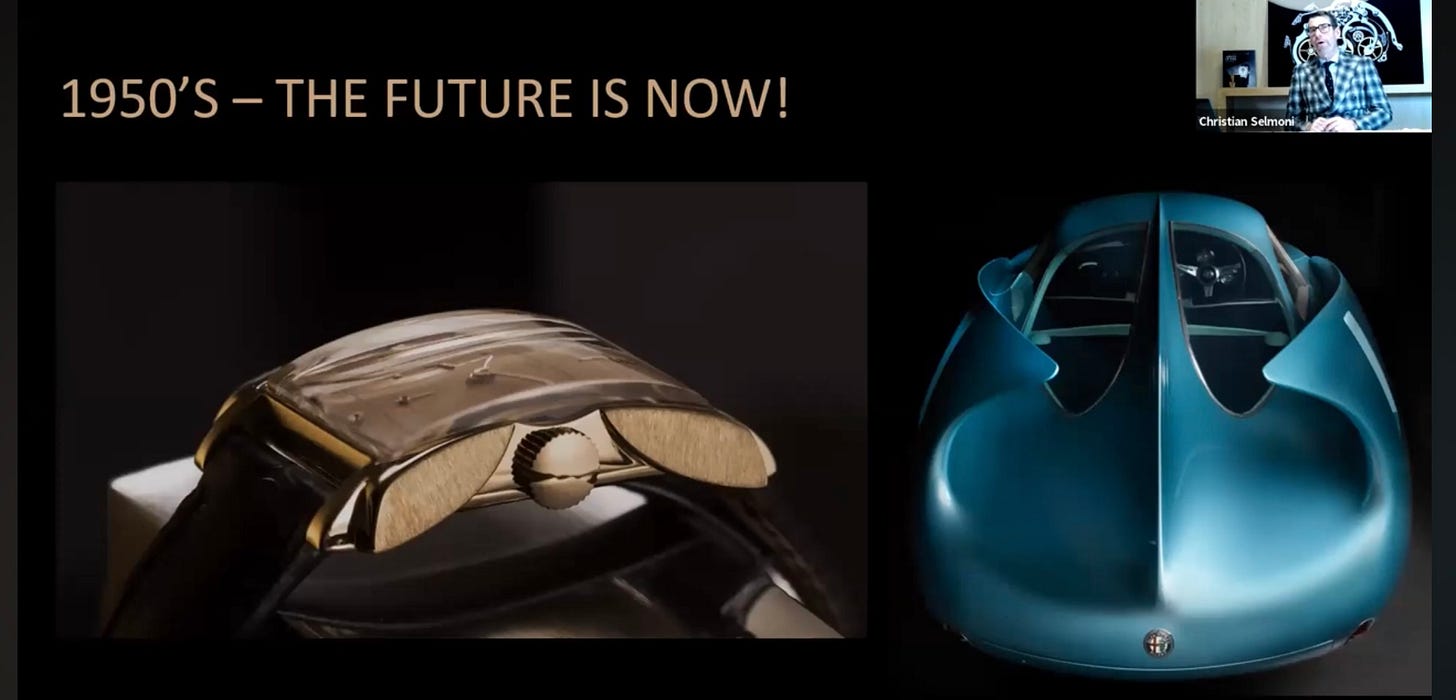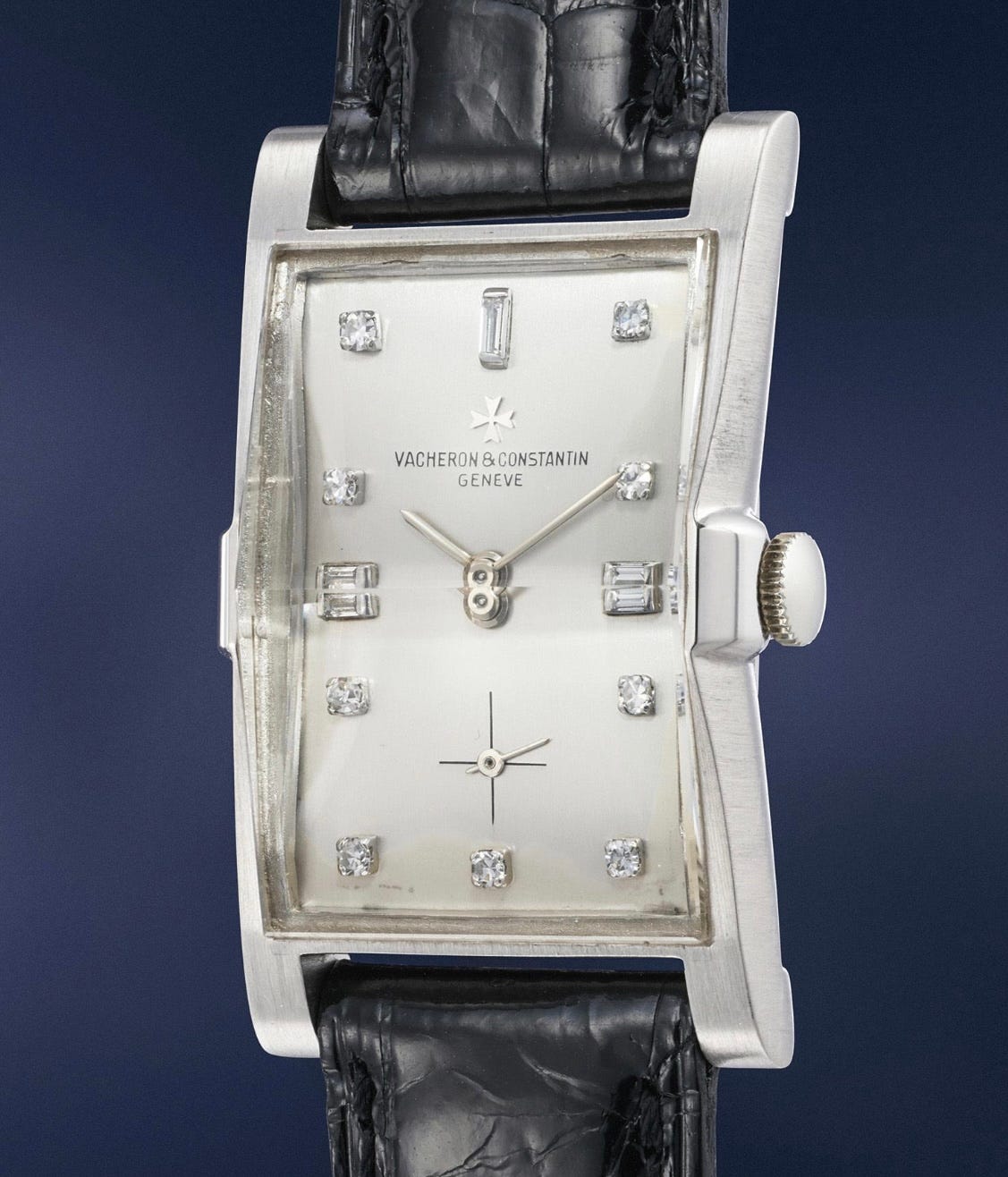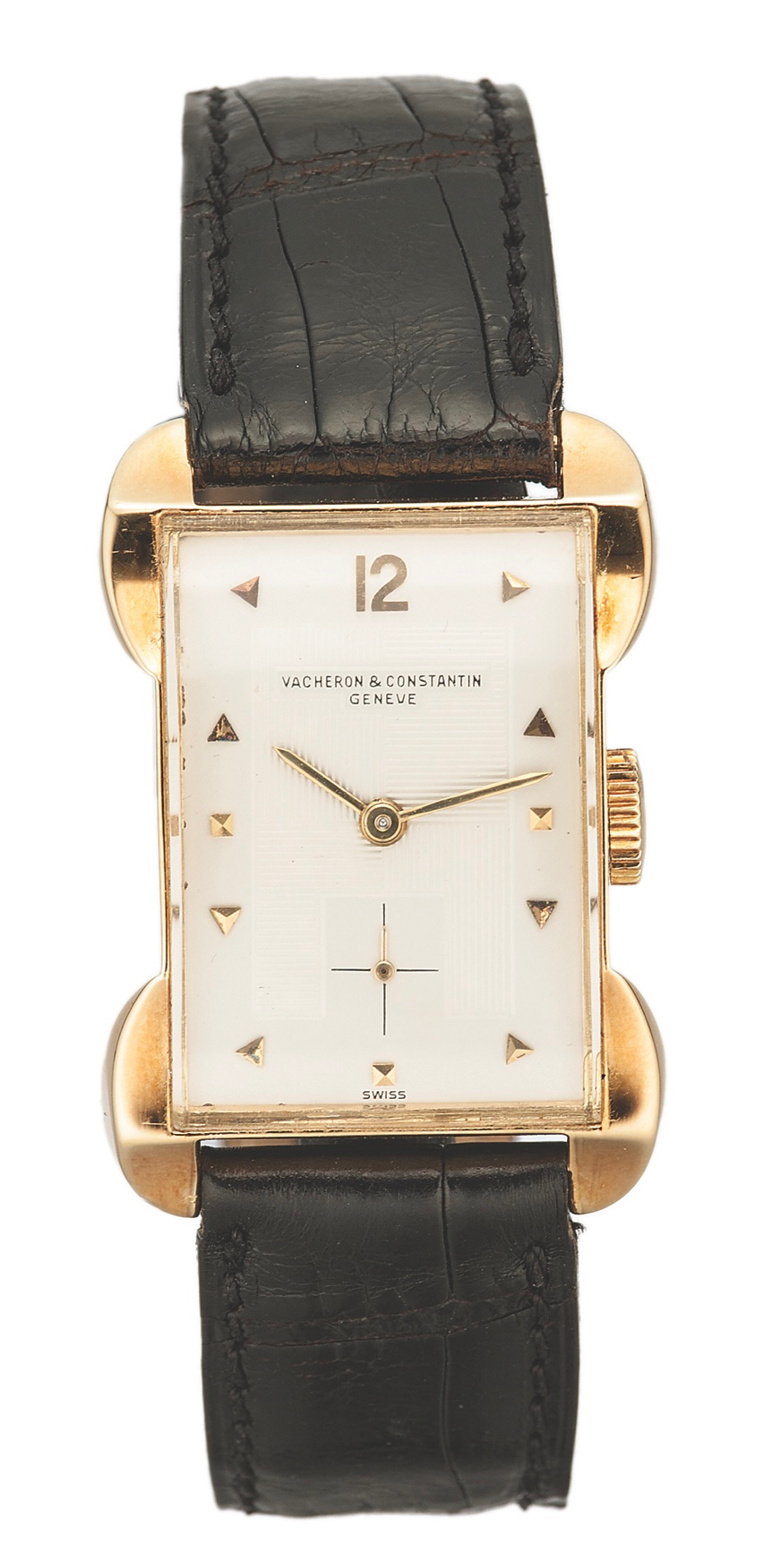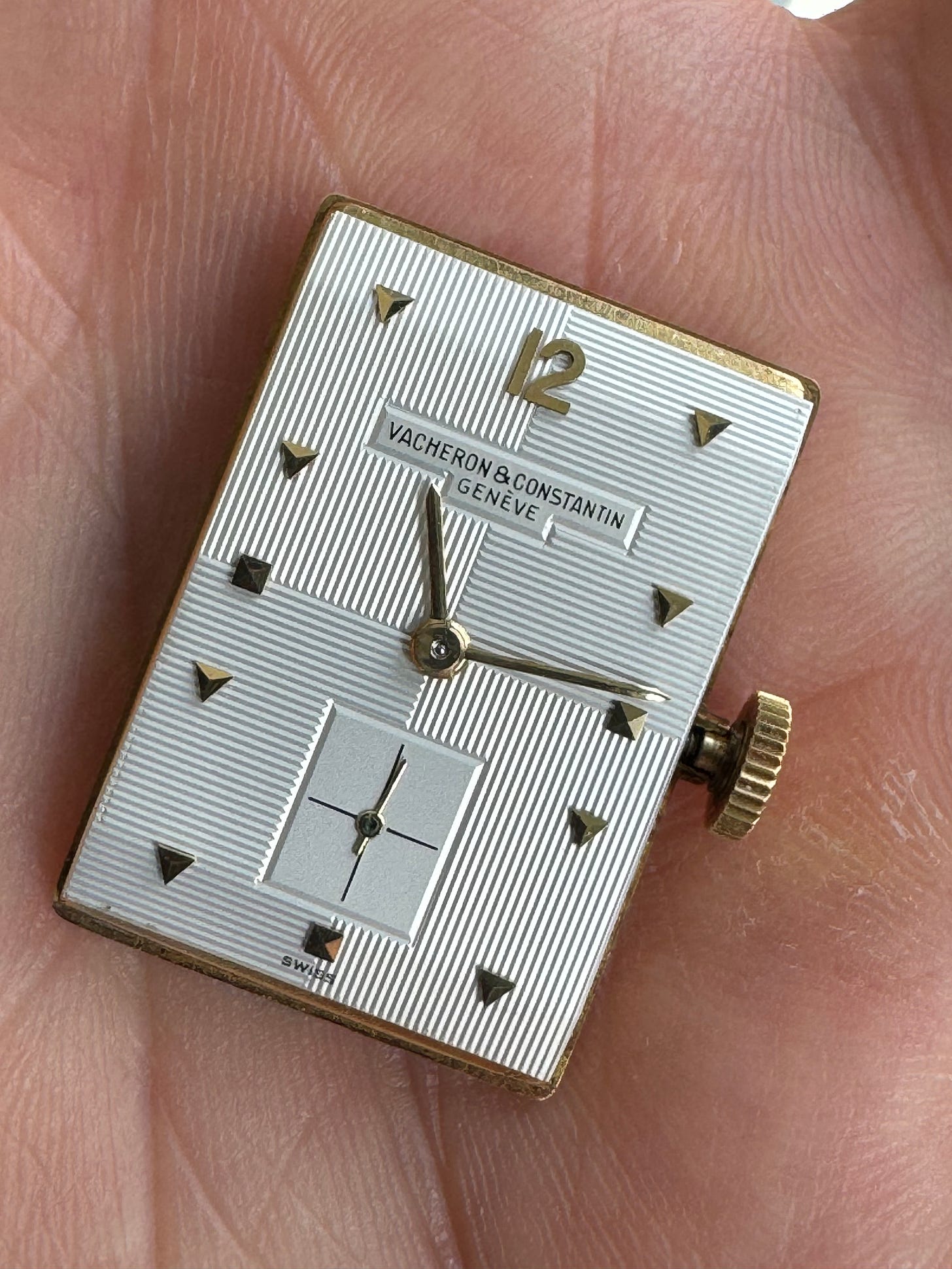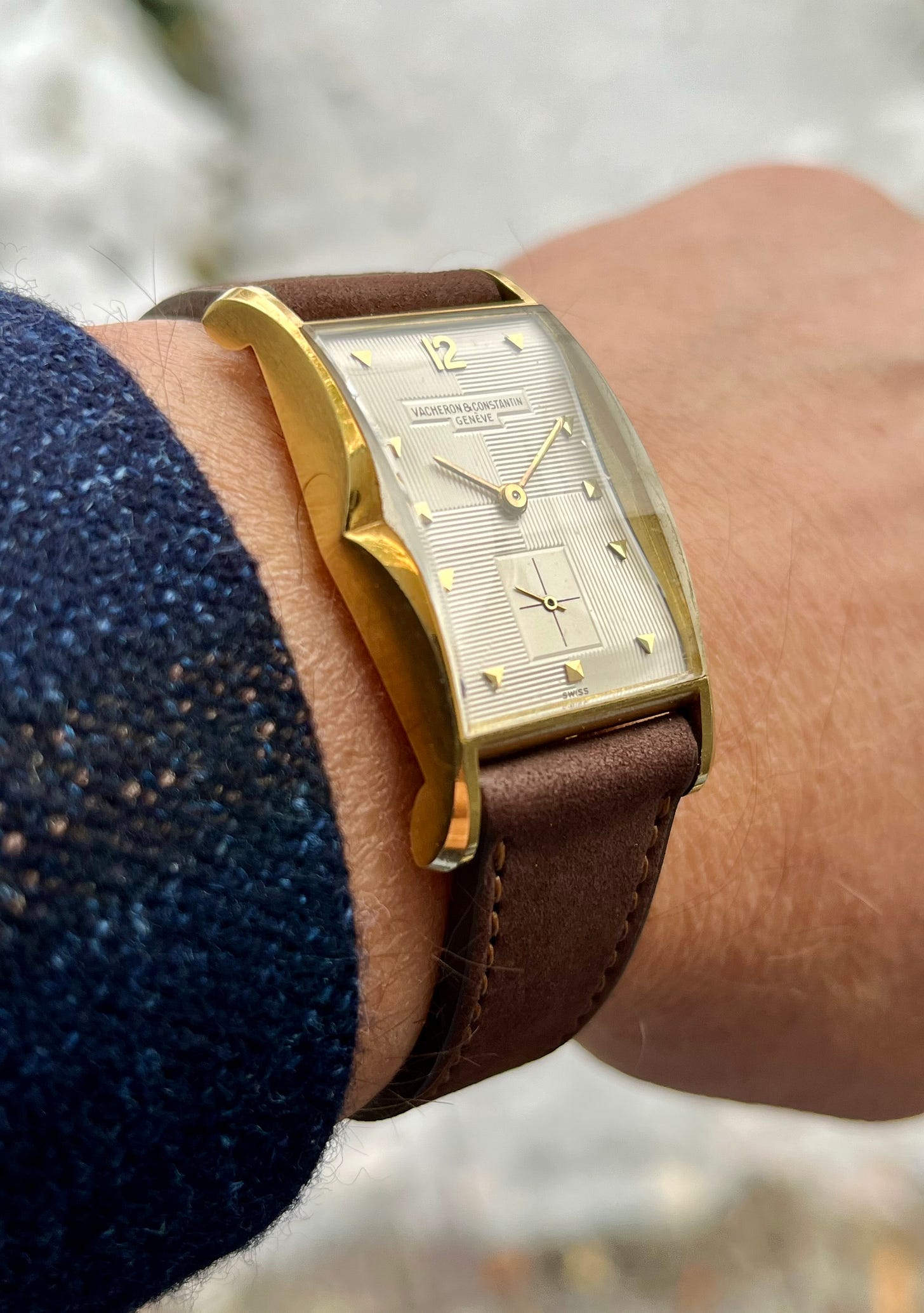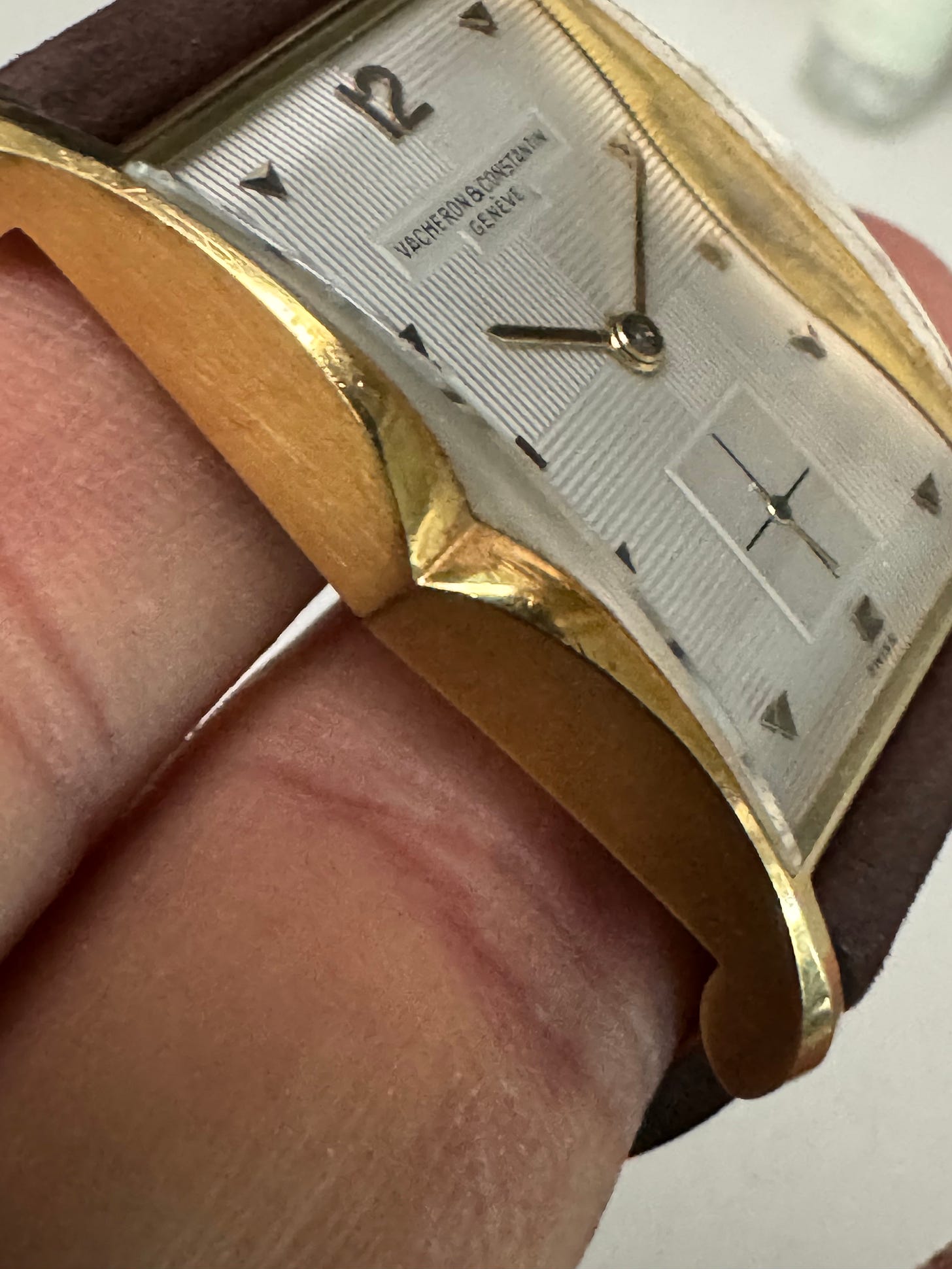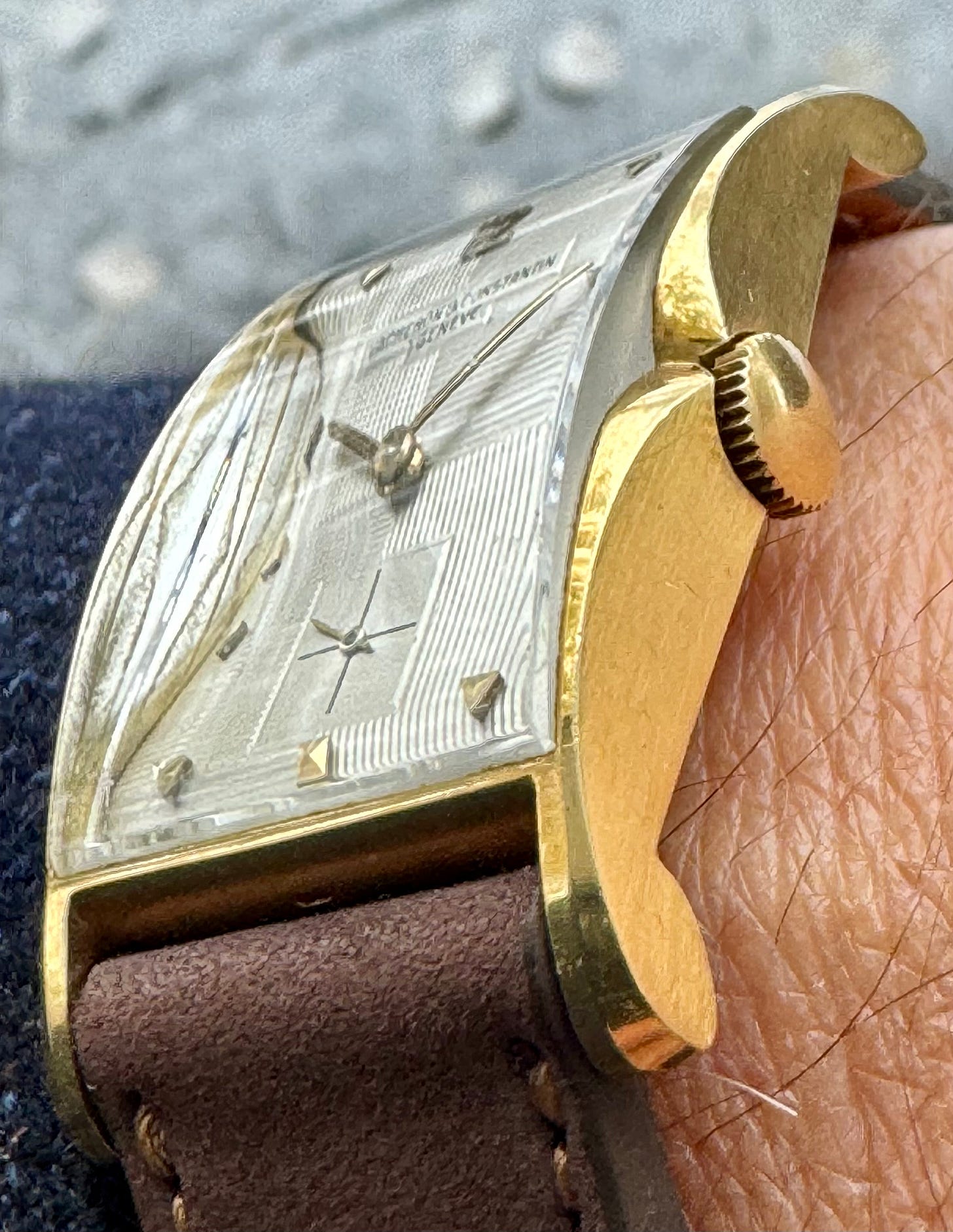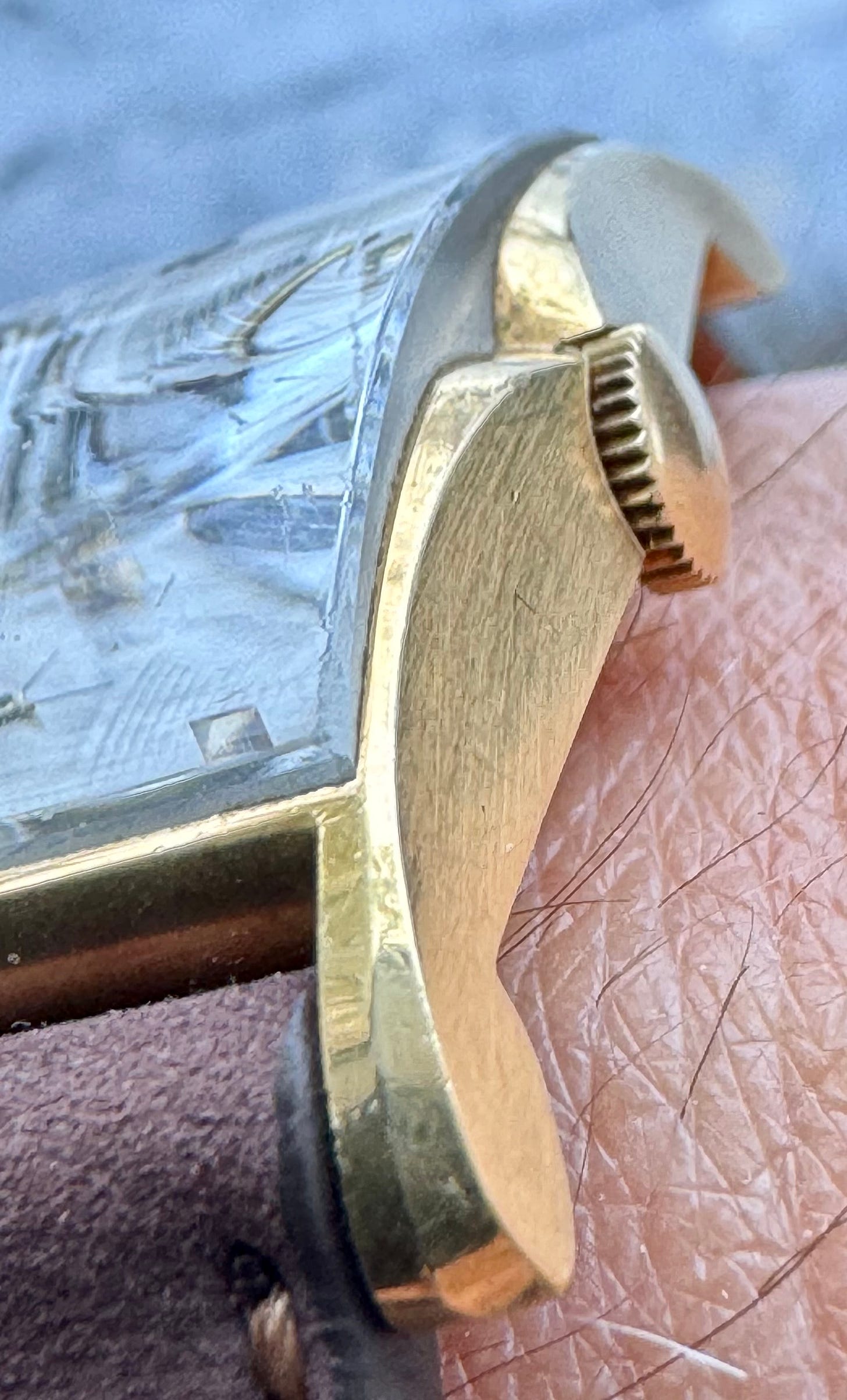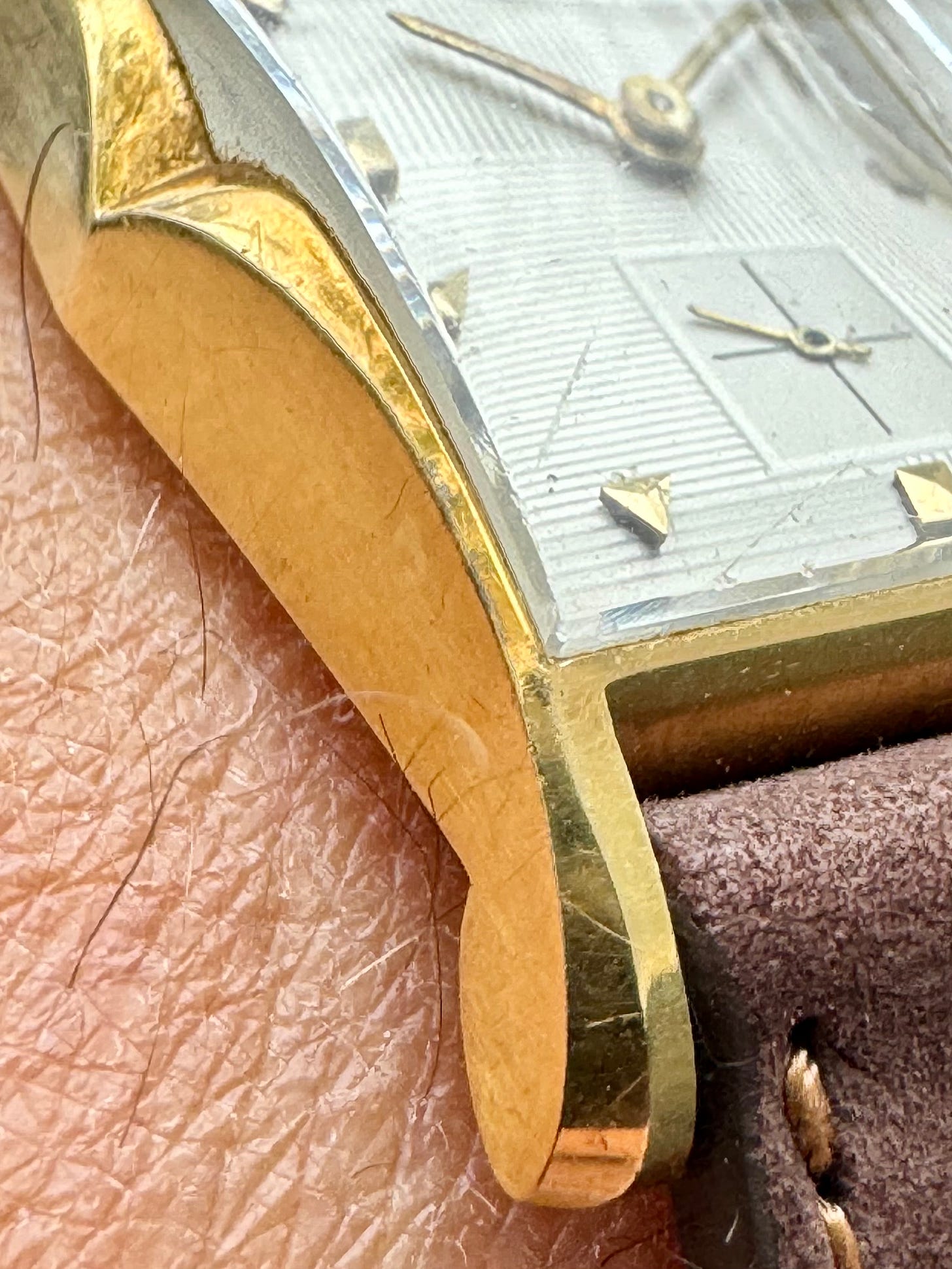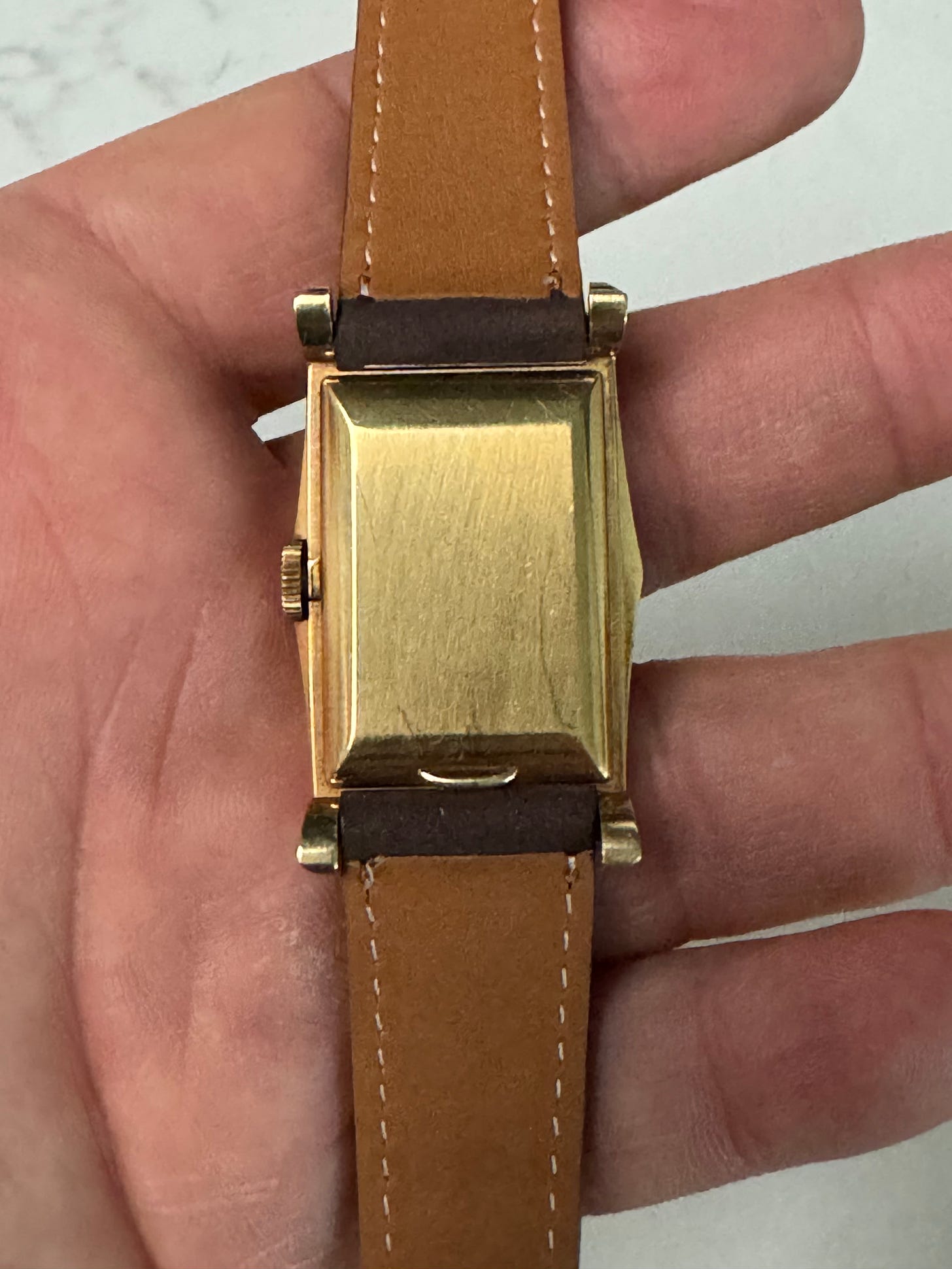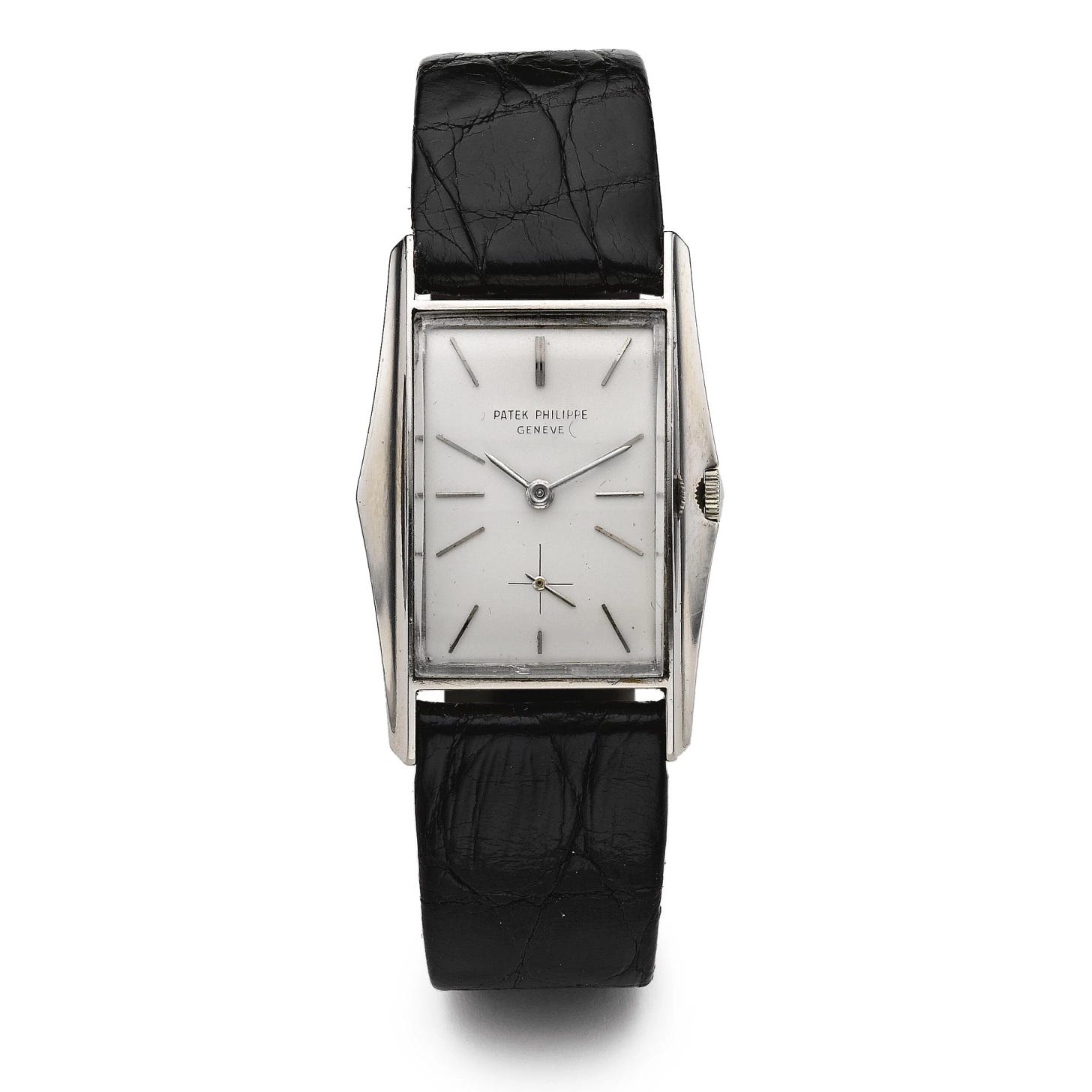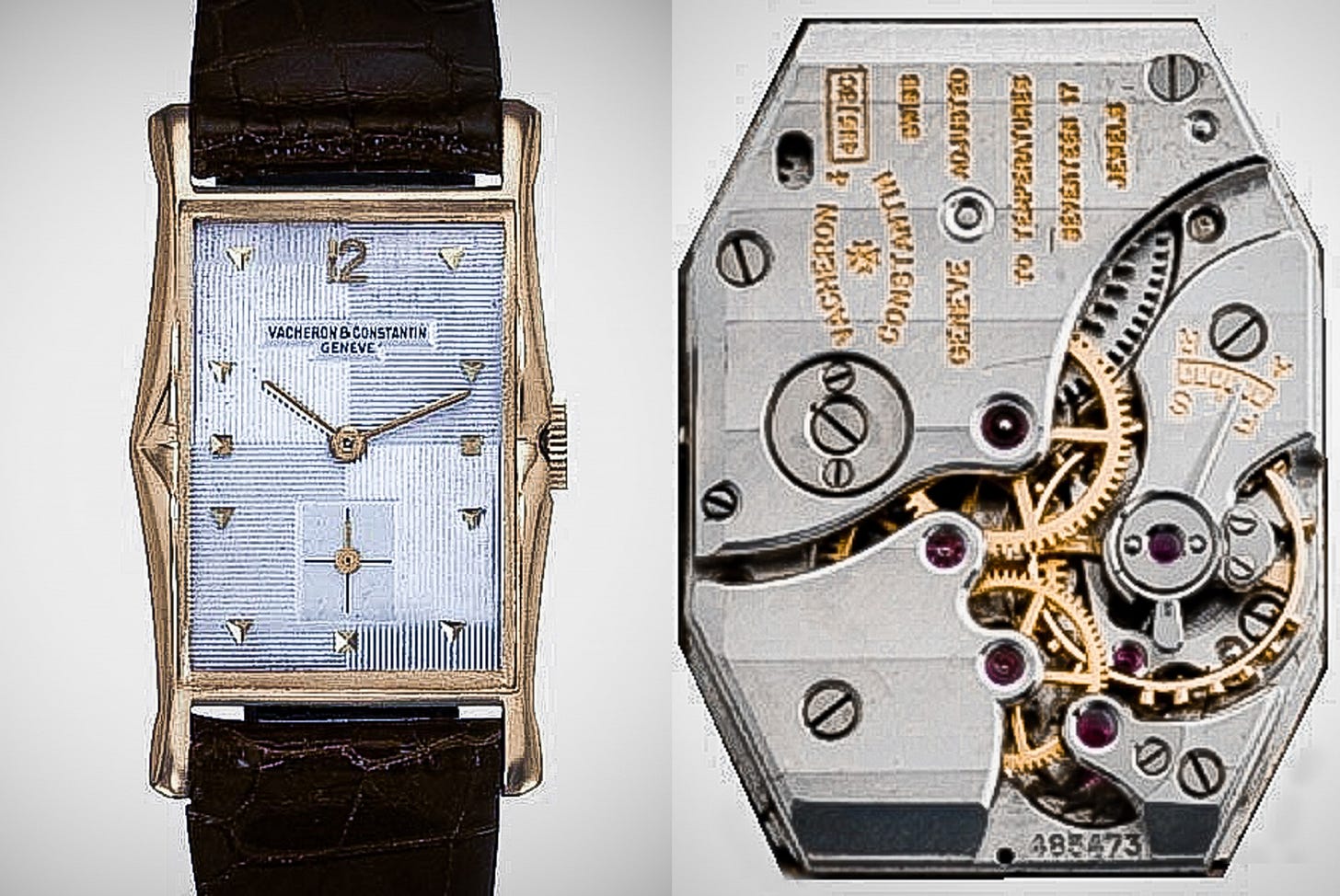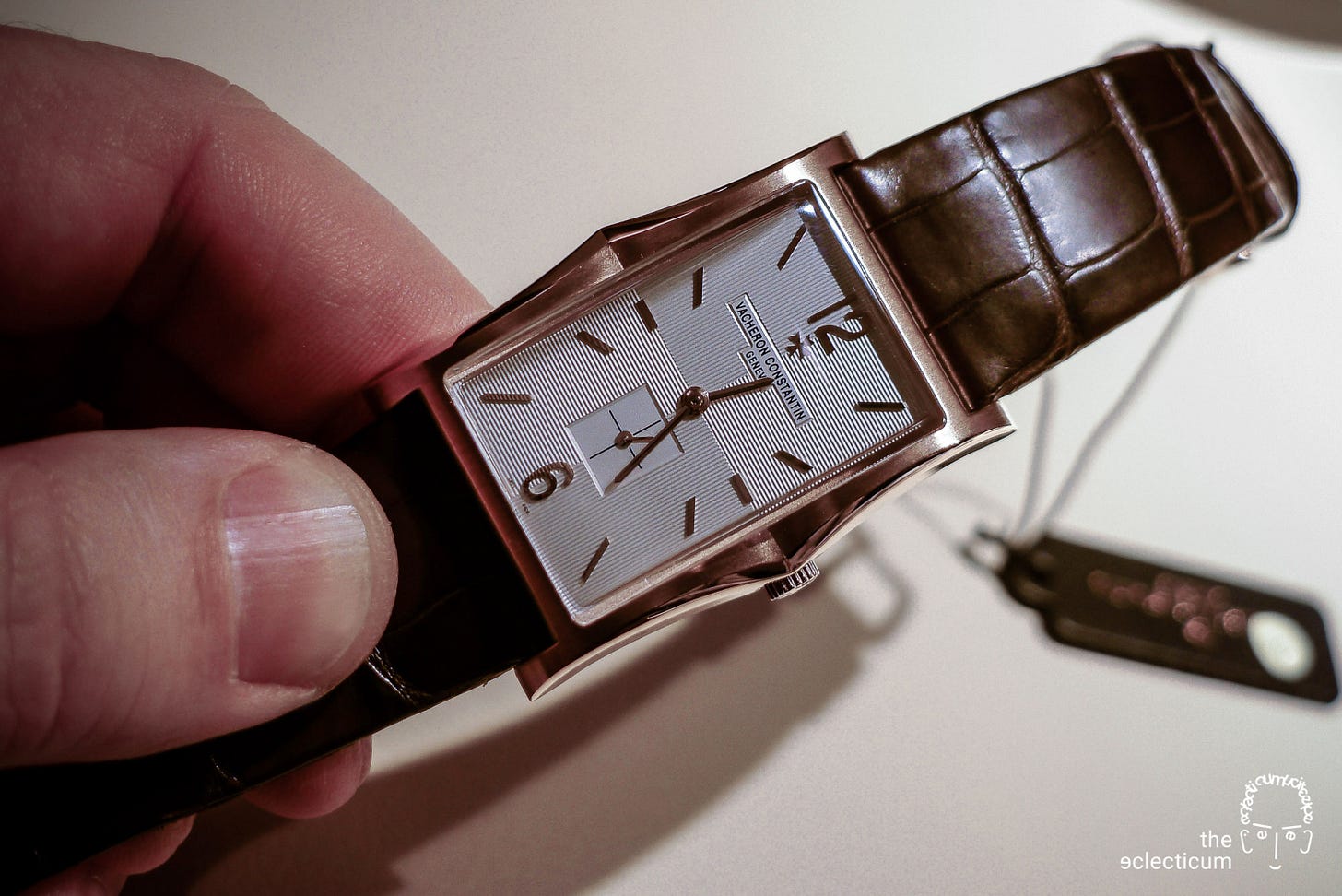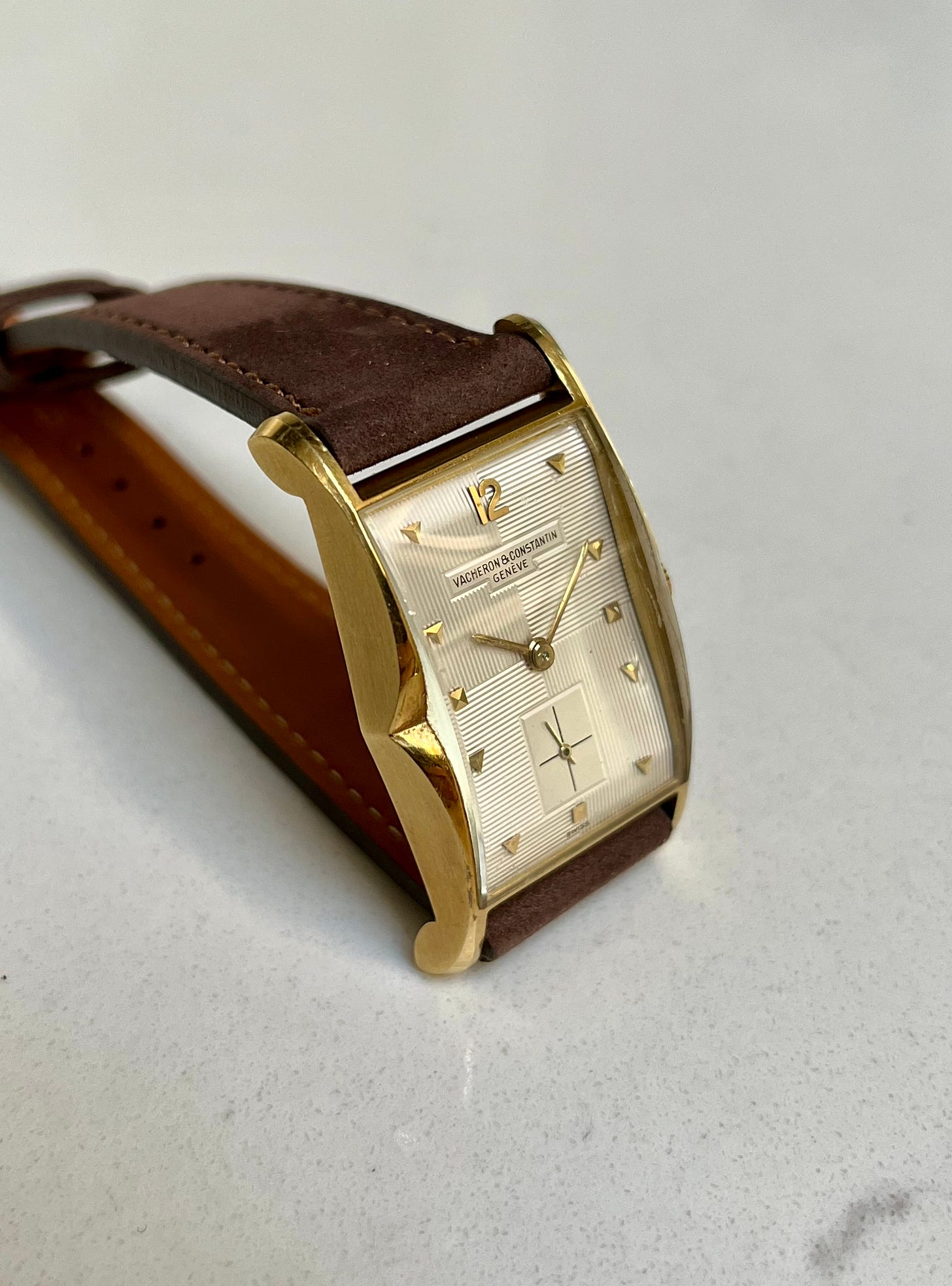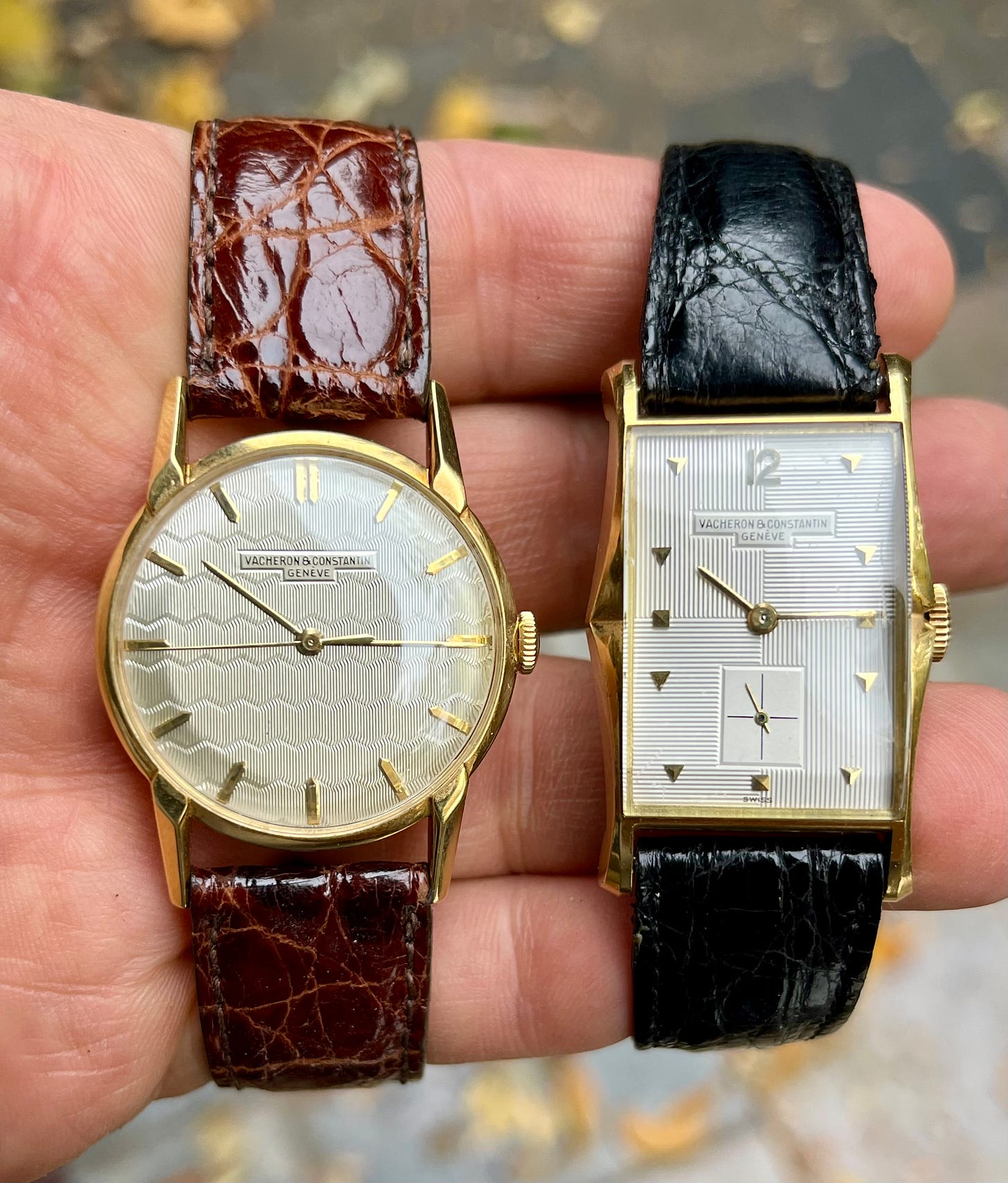Figs. 1, 2 - Vacheron Constantin ref. 4984, so-called “Lips” circa 1954 on the wrist. Note the different light conditions and their effect on the dial’s appearance.
Background
During the ‘50’s, Vacheron Constantin produced some daring case and dial designs that reflected the exuberance of the time, somewhat in parallel to the avant garde designs seen in the automotive world. These designs were not just unique in terms of case shapes with curved lines but also offered interesting dial layouts, often featuring unique, chic guilloche patterns or diamond indices. These emblematic designs have served as inspiration for watchmaking since their appearance.
The main subject of this writing is a Vacheron Constantin reference 4984 from 1954. It was a rectangular design Vacheron Constantin produced during the era, in addition to other noteworthy and rare, artistic rectangular references such as the 4591 (Fig. 5), 4739 (Fig. 6) and 4775 (Figs. 3, 4).
Let me digress momentarily to comment about Vacheron Constantin in general. A great review of the history of Vacheron Constantin can be found Here from a past lecture at the NY Horological Society titled “Journey Through the Secrets of Vacheron Constantin” presented by Christian Selmoni @selmoni.christian, Heritage & Style Director of Vacheron Constantin. Fig. 4 below is seen near the 1:08.05 mark of the lecture and depicts the rare rectangular reference 4775 from the ‘50’s with flared lugs resembling butterfly wings. In this segment of the lecture, there is some brief discussion acknowledging Vacheron Constantin made some of their creative references in extremely low production. From personal conversation with Christian, it was shared that arriving at an exact number of a given vintage reference originally produced is very difficult, due to the chronological nature of the archives and in some cases incomplete data with respect to cataloguing a certain reference. As such, we are left to speculate on the actual original production of some references. I can also share from personal research, that I was able to locate a record of just 5 unique public auction offerings of ref. 4984 by the large auction houses and do not have information on other examples that may be known privately outside of the auction space, such as subject example. A special thanks to Christian for his assistance in sharing some background information and for documenting the subject example’s correctness and year of production.
Fig. 3 - Vacheron Constantin ref. 4775, so-called “Butterfly”, circa 1955. Image courtesy of Phillips auctions.
Fig. 4 - Vacheron Constantin ref. 4775 pictured next to an Alfa Romeo, as featured in Christian Selmoni’s presentation to the NY Horological Society on January 6, 2021.
Fig. 5 - Vacheron Constantin ref. 4591, so-called “Hour Glass” circa 1959, courtesy of Phillips auctions. Note the similarity of a pitched crystal to the Patek 1593 “Hour Glass”. Interestingly, the applied Maltese cross logo is believed to have made its appearance sporadically on some dials as early as 1948.
Fig. 6 - Vacheron Constantin ref. 4739, so-called “Topolino” circa 1951, courtesy of Antiquorum auctions. An almost identical case shape is also seen on the Patek ref. 2503.
The 4984 Dial
Featuring a quadrant layout with alternating vertical and horizontal guilloche patterns that span to the dial edges and smooth stampings for sector sub seconds and signature with printed Swiss at the bottom. The signature and the sector sub seconds markers are executed in engraved enamel. Note the quadrant theme is carried from the 15 minute segments with contrasting guilloche to the stamped sector hash of the sub seconds and its squared surrounding borders. The markers lend a sense of flight or forward motion to the dial with the angled and faceted triangular markers, alternating pyramid shaped 3, 6 and 9 with the lone arabic marker at 12 and baton shaped hands tracking the time. It’s speculated and likely that the dials were supplied by Stern Freres at the time with the engraved, enameled signature, including the guilloche. Some of these Stern Freres guilloche machines are now with Vacheron Constantin.
With consideration of the dial markers, guilloche engraving and complementary smooth stampings for the upper signature and lower sub seconds, the dial is quite balanced, elaborate and elegant in its execution. The unrestored condition observed with a complete and bold engraved enamel signature is impressive.
Figs. 7-9 - Dial out of case showing exceptionally preserved condition. Note the complete and original engraved, enameled signature and dimension of alternating horizontal and vertical guilloche patterns.
The 4984 Case
The case is a complicated design and was made by famed casemaker Francois Markowski, Key 8. Markowski is known for artistic and formed case designs from this era and was also the case maker for the previously mentioned unique rectangular Vacheron Constantin refs. 4591, 4775 and 4739. Markowski is also noted for some famous Patek case references, such as the so-called “Eiffel Tower” 2441, “Hourglass” 1593, “Tophat” 1450, “Manta Ray” 2554 (Fig. 18) and the very intriguing Gilbert Albert references as published by John Reardon Here.
This ref. 4984 case presents in top level condition when compared to other examples known, retains its original finish, crisp transitions and is unpolished. The case size was considered quite large for the period, measuring approx. 24mm wide by 40mm in length. It wears nicely on the wrist and commands a definite, yet comfortable presence.
Note the elegant profile views featuring the original satin finish contrasting with the polished finish and elaborate concave design resembling lips, wings or a mustache when viewed from the side. The outer lugs flare outward in similar fashion to the Patek ref. 1593, yet feature beautiful chamfers on the edges that span from the mid-section of the case and expand to the lug tips. The winding crown is original and partially recessed into the case and actuated by pulling from the bottom. The opposing case side features an apex on the side profile which meets the convex portion immediately above.
The crystal appears original, has a few marks from wear, yet is noted for the beautiful domed profile that also makes taking pictures a bit difficult. It features beveled edges that completely border the entire span, whereas replacement crystals don’t typically have this extra detail. The facets are more visible in the enlarged pics below.
Figs. 10- 17. Note the elegance and attention to detail shown in the profile views, partially recessed crown, lug chamfers, deep and crisp hallmark, original satin finish on case sides, snapback and completely beveled and domed crystal.
Fig. 18 - Patek 2554G so-called “Manta Ray” from 1958 with a cleaned dial featuring a similar shaped and more subdued case, as also designed by Francois Markowski. Picture courtesy of Sotheby’s auctions.
The 4984 Movement
The shaped movement is reference 435/3C, which is based on a LeCoultre ebauche. I’m sharing a pic of this movement type below from the public domain for reference. The execution and finishing of the movement was to very high standards, featuring hand finished Geneva waves, anglage and perlage on the base plate.
Fig. 19 - 435/3C movement image courtesy of “the eclectium”.
In Summary
A stunning and very rare reference by the numbers known and for the condition observed. As a collector, it’s always exciting to find interesting examples that have survived many decades, preserved in unrestored and top condition for the age. As mentioned earlier, from my research I located record of only 5 additional ref. 4984 examples known to market via the major auction houses, three in yellow gold and two in pink gold. It appears the reference was produced during a very brief span up to 1955.
In 2011 at SIHH, Vacheron Constantin launched the contemporary “Aronde 1954” model in it’s “Historiques” collection, which was designed as an homage to resemble the ref. 4984. Although similar in appearance, it is not identical when compared to the ref. 4984 in the execution of its case and dial. The Aronde 1954 also differs in that it features a round vs. shaped movement as was seen in the ref. 4984. It does offer a modern interpretation of this interesting reference and that certainly has its own appeal. I personally prefer the charm and overall execution of the vintage reference, albeit they are difficult to find given the very low numbers known, so a welcomed gesture to offer a similar looking and modern example for collectors to enjoy. It is interesting that Vacheron Constantin decided to release a modern reference that was inspired by such a low production vintage reference and as such, speaks to the unique design appeal. It’s nice to see a manufacturer reach back to an era of evocative design to inspire a new contemporary offering.
Figs. 20, 21 - “Aronde 1954” from the “Historiques” collection. Views of the case profile, dial and round movement. Photos courtesy of “the eclecticum”.
I personally believe vintage Vacheron Constantin references such as subject example are very interesting and represent a high water mark for haute horology design during the era. Collectors would be well advised to appreciate this brand for its vintage proposition of value to quality of execution. I appreciate some of the special and unique vintage offerings from the brand in top condition as complimentary and diversified additions to a collection. The references mentioned here are truly scarce by the numbers and if well preserved, among the highest quality of “complete packages” (dial, case, movement) produced during the time. Please enjoy the closing side profile pics of this example (Figs. 22, 23) and side by side pairing pics with another period Vacheron Constantin reference 4897, now in the personal collection of Roni Madhavani @roni_m_29 (Figs. 24, 25)
.Figs. 22, 23 - side profile views of ref. 4984.
Figs. 24, 25 - side by side with ref. 4897 featuring a unique wavy pattern guilloche dial. An interesting guilloche dial comparison and contrast of styles offered by Vacheron Constantin in the ‘50’s.
Thanks for reading.
@aircooltime

